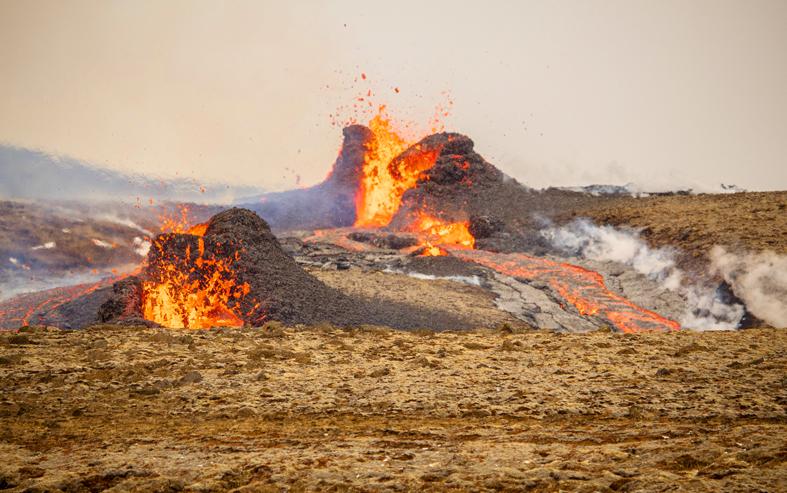Steam and lava on Monday spurted from a new fissure on an Icelandic volcano that began erupting last month, prompting the evacuation of hundreds of hikers who had come to see the spectacle.
The new fissure, first spotted by a sightseeing helicopter, was about 500m long and about 1km from the original eruption site in the Geldinga Valley.
The Icelandic Department of Emergency Management announced an immediate evacuation of the area, saying that there was no imminent danger to life due to the site’s distance from popular hiking paths.

Photo: AP
The new volcanic activity was not expected to affect traffic at nearby Keflavik Airport, the Icelandic Meteorological Office said.
The long-dormant volcano on the Reykjanes Peninsula in southwest Iceland flared to life on March 20 after tens of thousands of earthquakes were recorded in the area in the past three weeks.
It was the area’s first volcanic eruption in nearly 800 years.
Live footage from the area showed small spouts of lava coming from the new fissure.
Geophysicist Magnus Gudmundsson said that the volcanic eruption could be moving north from its original location.
“We now see less lava coming from the two original craters,” he said. “This could be the beginning of a second stage.”
Iceland, located above a volcanic hot spot in the North Atlantic, averages one volcanic eruption every four to five years.

When Shanghai-based designer Guo Qingshan posted a vacation photo on Valentine’s Day and captioned it “Puppy Mountain,” it became a sensation in China and even created a tourist destination. Guo had gone on a hike while visiting his hometown of Yichang in central China’s Hubei Province late last month. When reviewing the photographs, he saw something he had not noticed before: A mountain shaped like a dog’s head rested on the ground next to the Yangtze River, its snout perched at the water’s edge. “It was so magical and cute. I was so excited and happy when I discovered it,” Guo said.

Chinese authorities said they began live-fire exercises in the Gulf of Tonkin on Monday, only days after Vietnam announced a new line marking what it considers its territory in the body of water between the nations. The Chinese Maritime Safety Administration said the exercises would be focused on the Beibu Gulf area, closer to the Chinese side of the Gulf of Tonkin, and would run until tomorrow evening. It gave no further details, but the drills follow an announcement last week by Vietnam establishing a baseline used to calculate the width of its territorial waters in the Gulf of Tonkin. State-run Vietnam News

TURNAROUND: The Liberal Party had trailed the Conservatives by a wide margin, but that was before Trump threatened to make Canada the US’ 51st state Canada’s ruling Liberals, who a few weeks ago looked certain to lose an election this year, are mounting a major comeback amid the threat of US tariffs and are tied with their rival Conservatives, according to three new polls. An Ipsos survey released late on Tuesday showed that the left-leaning Liberals have 38 percent public support and the official opposition center-right Conservatives have 36 percent. The Liberals have overturned a 26-point deficit in six weeks, and run advertisements comparing the Conservative leader to Trump. The Conservative strategy had long been to attack unpopular Canadian Prime Minister Justin Trudeau, but last month he

Four decades after they were forced apart, US-raised Adamary Garcia and her birth mother on Saturday fell into each other’s arms at the airport in Santiago, Chile. Without speaking, they embraced tearfully: A rare reunification for one the thousands of Chileans taken from their mothers as babies and given up for adoption abroad. “The worst is over,” Edita Bizama, 64, said as she beheld her daughter for the first time since her birth 41 years ago. Garcia had flown to Santiago with four other women born in Chile and adopted in the US. Reports have estimated there were 20,000 such cases from 1950 to